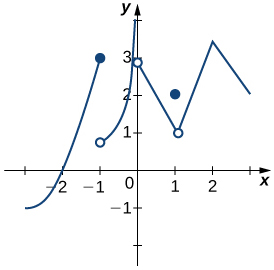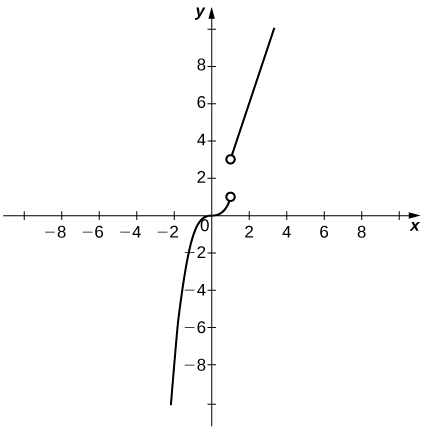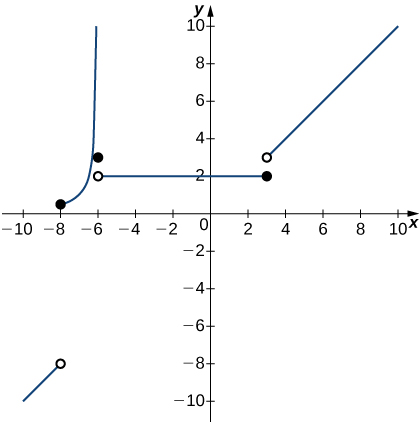2.6E: Continuity EXERCISES
- Last updated
- Jun 6, 2019
- Save as PDF
- Page ID
- 20577
( \newcommand{\kernel}{\mathrm{null}\,}\)
2.6: Continuity
For the following exercises, determine the point(s), if any, at which each function is discontinuous. Classify any discontinuity as jump, removable, infinite, or other.
131) f(x)=1√x
- Answer:
- The function is defined for all x in the interval (0,∞). In other words, this function is continuous on its domain.
132) f(x)=2x2+1
133) f(x)=xx2−x
- Answer:
- Removable discontinuity at x=0; infinite discontinuity at x=1
134) g(t)=t−1+1
135) f(x)=5ex−2
- Answer:
- Infinite discontinuity at x=ln2
136) f(x)=|x−2|x−2
137) H(x)=tan2x
- Answer:
- Infinite discontinuities at x=(2k+1)π4, for k=0,±1,±2,±3,…
138) f(t)=t+3t2+5t+6
For the following exercises, decide if the function is continuous at the given point. If it is discontinuous, what type of discontinuity is it?
139) 2x2−5x+3x−1 at x=1
- Answer:
- No. It is a removable discontinuity.
140) h(θ)=sinθ−cosθtanθ at θ=π
141) g(u)={6u2+u−22u−1ifu≠1272ifu=12, at u=12
141) g(u)={6u2+u−22u−1ifu≠1272ifu=12, at u=12
- Answer:
- Yes. It is continuous.
142) f(y)=sin(πy)tan(πy), at y=1
143) f(x)={x2−exifx<0x−1ifx≥0, at x=0
- Answer:
- Yes. It is continuous.
144) f(x)={xsin(x)ifx≤πxtan(x)ifx>π, at x=π
In the following exercises, find the value(s) of k that makes each function continuous over the given interval.
145) f(x)={3x+2x<k2x−3k≤x≤8
- Answer:
- k=−5
146) f(θ)={sinθ0≤θ<π2cos(θ+k)π2≤θ≤π
147) f(x)={x2+3x+2x+2x≠−2kx=−2
- Answer:
- k=−1
148) f(x)={ekx0≤x<4x+34≤x≤8
149) f(x)={√kx0≤x≤3x+13<x≤10
- Answer:
- k=163
In the following exercises, use the Intermediate Value Theorem (IVT).
150) Let h(x)={3x2−4x≤25+4xx>2 Over the interval [0,4], there is no value of x such that h(x)=10, although h(0)<10 and h(4)>10. Explain why this does not contradict the IVT.
151) A particle moving along a line has at each time t a position function s(t), which is continuous. Assume s(2)=5 and s(5)=2. Another particle moves such that its position is given by h(t)=s(t)−t. Explain why there must be a value c for 2<c<5 such that h(c)=0.
- Answer:
- Since both s and y=t are continuous everywhere, then h(t)=s(t)−t is continuous everywhere and, in particular, it is continuous over the closed interval [2,5]. Also, h(2)=3>0 and h(5)=−3<0. Therefore, by the IVT, there is a value x=c such that h(c)=0.
152) [T] Use the statement “The cosine of t is equal to t cubed."
a. Write a mathematical equation of the statement.
b. Prove that the equation in part a. has at least one real solution.
c. Use a calculator to find an interval of length 0.01 that contains a solution.
153) Apply the IVT to determine whether 2x=x3 has a solution in one of the intervals [1.25,1.375] or [1.375,1.5]. Briefly explain your response for each interval.
- Answer:
- The function f(x)=2x−x3 is continuous over the interval [1.25,1.375] and has opposite signs at the endpoints.
154) Consider the graph of the function y=f(x) shown in the following graph.

a. Find all values for which the function is discontinuous.
b. For each value in part a., state why the formal definition of continuity does not apply.
c. Classify each discontinuity as either jump, removable, or infinite.
155) Let f(x)={3xx>1x3x<1.
a. Sketch the graph of f.
b. Is it possible to find a value k such that f(1)=k, which makes f(x) continuous for all real numbers? Briefly explain.
- Answer:
-
a.

b. It is not possible to redefine f(1) since the discontinuity is a jump discontinuity.
156) Let f(x)=x4−1x2−1 for x≠−1,1.
a. Sketch the graph of f.
b. Is it possible to find values k1 and k2 such that f(−1)=k and f(1)=k2, and that makes f(x) continuous for all real numbers? Briefly explain.
157) Sketch the graph of the function y=f(x) with properties i. through vii.
- i. The domain of f is (−∞,+∞).
- ii. f has an infinite discontinuity at x=−6.
- iii. f(−6)=3
- iv. lim
- v. f(−3)=3
- vi. f is left continuous but not right continuous at x=3.
- vii. \displaystyle \lim_{x→−∞}f(x)=−∞ and \displaystyle \lim_{x→+∞}f(x)=+∞
- Answer:
-
Answers may vary; see the following example:

158) Sketch the graph of the function y=f(x) with properties i. through iv.
- i. The domain of f is [0,5].
- ii. \displaystyle \lim_{x→1^+}f(x) and \displaystyle \lim_{x→1^−}f(x) exist and are equal.
- iii. f(x) is left continuous but not continuous at x=2, and right continuous but not continuous at x=3.
- iv. f(x) has a removable discontinuity at x=1, a jump discontinuity at x=2, and the following limits hold: \displaystyle \lim_{x→3^−}f(x)=−∞ and \displaystyle \lim_{x→3^+}f(x)=2.
In the following exercises, suppose y=f(x) is defined for all x. For each description, sketch a graph with the indicated property.
159) Discontinuous at x=1 with \displaystyle \lim_{x→−1}f(x)=−1 and \displaystyle \lim_{x→2}f(x)=4
- Answer:
-
Answers may vary; see the following example:

160) Discontinuous at x=2 but continuous elsewhere with \displaystyle \lim_{x→0}f(x)=\frac{1}{2}
Determine whether each of the given statements is true. Justify your response with an explanation or counterexample.
161) f(t)=\frac{2}{e^t−e^{−t}} is continuous everywhere.
- Answer:
- False. It is continuous over (−∞,0) ∪ (0,∞).
162) If the left- and right-hand limits of f(x) as x→a exist and are equal, then f cannot be discontinuous at x=a.
163) If a function is not continuous at a point, then it is not defined at that point.
- Answer:
- False. Consider f(x)=\begin{cases}x & if x≠0\\ 4 & if x=0\end{cases}.
164) According to the IVT, cosx−sinx−x=2 has a solution over the interval [−1,1].
165) If f(x) is continuous such that f(a) and f(b) have opposite signs, then f(x)=0 has exactly one solution in [a,b].
- Answer:
- False. Consider f(x)=cos(x) on [−π,2π].
166) The function f(x)=\frac{x^2−4x+3}{x^2−1} is continuous over the interval [0,3].
167) If f(x) is continuous everywhere and f(a),f(b)>0, then there is no root of f(x) in the interval [a,b].
- Answer:
- False. The IVT does not work in reverse! Consider (x−1)^2 over the interval [−2,2].
[T] The following problems consider the scalar form of Coulomb’s law, which describes the electrostatic force between two point charges, such as electrons. It is given by the equation F(r)=k_e\frac{|q_1q_2|}{r^2}, where k_e is Coulomb’s constant, q_i are the magnitudes of the charges of the two particles, and r is the distance between the two particles.
168) To simplify the calculation of a model with many interacting particles, after some threshold value r=R, we approximate F as zero.
a. Explain the physical reasoning behind this assumption.
b. What is the force equation?
c. Evaluate the force F using both Coulomb’s law and our approximation, assuming two protons with a charge magnitude of 1.6022×10^{−19} coulombs (C), and the Coulomb constant k_e=8.988×10^9Nm^2/C^2 are 1 m apart. Also, assume R<1m. How much inaccuracy does our approximation generate? Is our approximation reasonable?
d. Is there any finite value of R for which this system remains continuous at R?
169) Instead of making the force 0 at R, instead we let the force be 10−20 for r≥R. Assume two protons, which have a magnitude of charge 1.6022×10^{−19}C, and the Coulomb constant k_e=8.988×10^9Nm^2/C^2. Is there a value R that can make this system continuous? If so, find it.
- Answer:
- R=0.0001519m
Recall the discussion on spacecraft from the chapter opener. The following problems consider a rocket launch from Earth’s surface. The force of gravity on the rocket is given by F(d)=−mk/d^2, where m is the mass of the rocket, d is the distance of the rocket from the center of Earth, and k is a constant.
170) [T] Determine the value and units of k given that the mass of the rocket on Earth is 3 million kg. (Hint: The distance from the center of Earth to its surface is 6378 km.)
171) [T] After a certain distance D has passed, the gravitational effect of Earth becomes quite negligible, so we can approximate the force function by F(d)=\begin{cases}−\frac{mk}{d^2} & if d<D\\ 10,000 & if d≥D\end{cases}. Find the necessary condition D such that the force function remains continuous.
- Answer:
- D=63.78km
172) As the rocket travels away from Earth’s surface, there is a distance D where the rocket sheds some of its mass, since it no longer needs the excess fuel storage. We can write this function as F(d)=\begin{cases} −\frac{m_1k}{d^2} & if d<D \\ −\frac{m_2k}{d^2} & if d≥D\end{cases}. Is there a D value such that this function is continuous, assuming m_1≠m_2?
Prove the following functions are continuous everywhere
173) f(θ)=sinθ
- Answer:
- For all values of a, f(a) is defined, lim_{θ→a}f(θ) exists, and lim_{θ→a}f(θ)=f(a). Therefore, f(θ) is continuous everywhere.
174) g(x)=|x|
175) Where is f(x)=\begin{cases} 0 & \text{if x is irrational}\\ 1 & \text{if x is rational}\end{cases} continuous?
- Answer:
- Nowhere

